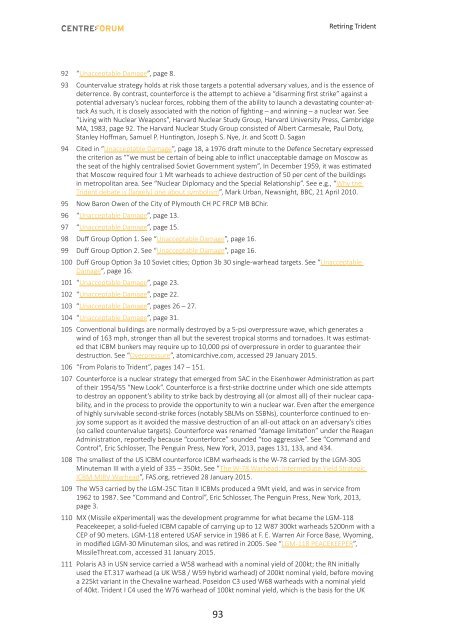Retiring Trident
retiring-trident
retiring-trident
Create successful ePaper yourself
Turn your PDF publications into a flip-book with our unique Google optimized e-Paper software.
<strong>Retiring</strong> <strong>Trident</strong><br />
92 “Unacceptable Damage”, page 8.<br />
93 Countervalue strategy holds at risk those targets a potential adversary values, and is the essence of<br />
deterrence. By contrast, counterforce is the attempt to achieve a “disarming first strike” against a<br />
potential adversary’s nuclear forces, robbing them of the ability to launch a devastating counter-attack<br />
As such, it is closely associated with the notion of fighting – and winning – a nuclear war. See<br />
“Living with Nuclear Weapons”, Harvard Nuclear Study Group, Harvard University Press, Cambridge<br />
MA, 1983, page 92. The Harvard Nuclear Study Group consisted of Albert Carmesale, Paul Doty,<br />
Stanley Hoffman, Samuel P. Huntington, Joseph S. Nye, Jr. and Scott D. Sagan<br />
94 Cited in “Unacceptable Damage”, page 18, a 1976 draft minute to the Defence Secretary expressed<br />
the criterion as ““we must be certain of being able to inflict unacceptable damage on Moscow as<br />
the seat of the highly centralised Soviet Government system”, In December 1959, it was estimated<br />
that Moscow required four 1 Mt warheads to achieve destruction of 50 per cent of the buildings<br />
in metropolitan area. See “Nuclear Diplomacy and the Special Relationship”. See e.g., “Why the<br />
<strong>Trident</strong> debate is (largely) one about symbolism”, Mark Urban, Newsnight, BBC, 21 April 2010.<br />
95 Now Baron Owen of the City of Plymouth CH PC FRCP MB BChir.<br />
96 “Unacceptable Damage”, page 13.<br />
97 “Unacceptable Damage”, page 15.<br />
98 Duff Group Option 1. See “Unacceptable Damage”, page 16.<br />
99 Duff Group Option 2. See “Unacceptable Damage”, page 16.<br />
100 Duff Group Option 3a 10 Soviet cities; Option 3b 30 single-warhead targets. See “Unacceptable<br />
Damage”, page 16.<br />
101 “Unacceptable Damage”, page 23.<br />
102 “Unacceptable Damage”, page 22.<br />
103 “Unacceptable Damage”, pages 26 – 27.<br />
104 “Unacceptable Damage”, page 31.<br />
105 Conventional buildings are normally destroyed by a 5-psi overpressure wave, which generates a<br />
wind of 163 mph, stronger than all but the severest tropical storms and tornadoes. It was estimated<br />
that ICBM bunkers may require up to 10,000 psi of overpressure in order to guarantee their<br />
destruction. See “Overpressure”, atomicarchive.com, accessed 29 January 2015.<br />
106 “From Polaris to <strong>Trident</strong>”, pages 147 – 151.<br />
107 Counterforce is a nuclear strategy that emerged from SAC in the Eisenhower Administration as part<br />
of their 1954/55 “New Look”. Counterforce is a first-strike doctrine under which one side attempts<br />
to destroy an opponent’s ability to strike back by destroying all (or almost all) of their nuclear capability,<br />
and in the process to provide the opportunity to win a nuclear war. Even after the emergence<br />
of highly survivable second-strike forces (notably SBLMs on SSBNs), counterforce continued to enjoy<br />
some support as it avoided the massive destruction of an all-out attack on an adversary’s cities<br />
(so called countervalue targets). Counterforce was renamed “damage limitation” under the Reagan<br />
Administration, reportedly because “counterforce” sounded “too aggressive”. See “Command and<br />
Control”, Eric Schlosser, The Penguin Press, New York, 2013, pages 131, 133, and 434.<br />
108 The smallest of the US ICBM counterforce ICBM warheads is the W-78 carried by the LGM-30G<br />
Minuteman III with a yield of 335 – 350kt. See “The W-78 Warhead: Intermediate Yield Strategic<br />
ICBM MIRV Warhead”, FAS.org, retrieved 28 January 2015.<br />
109 The W53 carried by the LGM-25C Titan II ICBMs produced a 9Mt yield, and was in service from<br />
1962 to 1987. See “Command and Control”, Eric Schlosser, The Penguin Press, New York, 2013,<br />
page 3.<br />
110 MX (Missile eXperimental) was the development programme for what became the LGM-118<br />
Peacekeeper, a solid-fueled ICBM capable of carrying up to 12 W87 300kt warheads 5200nm with a<br />
CEP of 90 meters. LGM-118 entered USAF service in 1986 at F. E. Warren Air Force Base, Wyoming,<br />
in modified LGM-30 Minuteman silos, and was retired in 2005. See “LGM-118 PEACEKEEPER”,<br />
MissileThreat.com, accessed 31 January 2015.<br />
111 Polaris A3 in USN service carried a W58 warhead with a nominal yield of 200kt; the RN initially<br />
used the ET.317 warhead (a UK W58 / W59 hybrid warhead) of 200kt nominal yield, before moving<br />
a 225kt variant in the Chevaline warhead. Poseidon C3 used W68 warheads with a nominal yield<br />
of 40kt. <strong>Trident</strong> I C4 used the W76 warhead of 100kt nominal yield, which is the basis for the UK<br />
93




